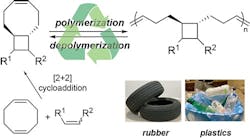Polymers Promise Better Sustainability
A group of researchers at the University of Akron (UA), Akron, Ohio, believe they have found a promising solution to address the challenges in plastics sustainability. The team has developed recyclable polymers with excellent thermal stability and the high-performance mechanical properties of traditional polymers. Yet, addition of a depolymerization catalyst allows recovery of monomers.
“We are particularly interested in chemically recyclable polymers that can be broken down into the constituents (monomers) from which they are made,” says Junpeng Wang, assistant professor in UA's School of Polymer Science and Polymer Engineering. “The recycled monomers can be reused to produce the polymers, allowing for a circular use of materials, which not only helps to preserve the finite natural resources used in plastics production, but also addresses the issue of unwanted end-of-life accumulation of plastic objects.”
The team identified the right monomer needed for designing chemically recyclable polymers through quantum chemical calculations, “which demonstrates a promise of exploiting data to discover and develop new materials,” notes Wang.
They then synthesized the monomer and polymers using abundantly available starting materials. An article in Nature Chemistry explains the research.
“The chemically recyclable polymers we developed show excellent thermal stability [decomposition temperature >370°C] and robust mechanical properties and can be used to prepare both rubber and plastics,” states Wang. “We expect this material to be an attractive candidate to replace current polymers. … Compared to other recyclable polymers that have been demonstrated, the new polymers show much better stability and more versatile mechanical properties. When a catalyst is added, the polymer can be degraded into the constituent monomer for recycling.”
Challenges remaining to address include scaling up the synthesis, use of environmentally benign media for depolymerization, and recycling of the depolymerization catalyst. However, the team’s current focus is on expanding the scope of the chemically recyclable polymers and to develop carbon-fiber-reinforced polymer (CFRP) composites.
Figure 1. Chemically recyclable polymers with excellent thermal stability and tunable mechanical properties show promise as next-generation sustainable materials. Source: Junpeng Wang, University of Akron.
“CFRPs are high-value materials used in the aerospace and automobile industries. Currently, most CFRPs are not recyclable. Since our recyclable polymers have excellent thermal stability and mechanical strength, they are good candidates to replace the polymer matrix used in CFRPs,” explains Wang.
The process also enables preparation of chemically recyclable polymers using bio-based olefins — work on that now is taking place, Wang notes.
The team plans to analyze the economic performance of the process and perform life-cycle analysis for commercialization of the polymers.
“The purpose of life-cycle analysis is to analyze the environmental impact of the chemically recyclable polymers if they are used for certain applications. It is a crucial premise before the commercialization of the polymers,” emphasizes Wang.
The researchers are in contact with industrial firms to collaborate on future development.

